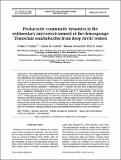Por favor, use este identificador para citar o enlazar a este item:
http://hdl.handle.net/10261/87335COMPARTIR / EXPORTAR:
 SHARE SHARE
 CORE
BASE CORE
BASE
|
|
| Visualizar otros formatos: MARC | Dublin Core | RDF | ORE | MODS | METS | DIDL | DATACITE | |

| Campo DC | Valor | Lengua/Idioma |
|---|---|---|
| dc.contributor.author | Quéric, Nadia V. | - |
| dc.contributor.author | Arrieta López de Uralde, Jesús M. | - |
| dc.contributor.author | Soltwedel, Thomas | - |
| dc.contributor.author | Arntz, Wolf E. | - |
| dc.date.accessioned | 2013-11-22T12:10:36Z | - |
| dc.date.available | 2013-11-22T12:10:36Z | - |
| dc.date.issued | 2008 | - |
| dc.identifier | doi: 10.3354/meps07582 | - |
| dc.identifier | issn: 0171-8630 | - |
| dc.identifier.citation | Marine Ecology - Progress Series 370: 87-95 (2008) | - |
| dc.identifier.uri | http://hdl.handle.net/10261/87335 | - |
| dc.description.abstract | The sedimentary microenvironment of a sessile epibenthic deep-sea species, the small demosponge Tentorium semisuberites, has been investigated to determine its effect on the distribution, physiology and community structure of benthic bacteria and archaea. The upper sediment layers (0 to 2 cm) in the immediate sponge vicinity were characterized by an increased bacterial colonisation with cell abundances on average 3 times higher than those in reference sediments. Similar results were obtained for bacterial secondary production, measured by simultaneous incorporation of the radioactive-labeled substrates 3H-thymidine and 14C-leucine. Our data show a high heterogene-ity of deep-sea sediments with a pronounced patchy distribution of particulate organic carbon (POC), and a significant enrichment of POC in the sediments next to T. semisuberites. Cell-specific 3H-thymidine and 14C-leucine incorporation rates indicate that the quality rather than the quantity of POC around sponges may lead to the observed increase in cell abundances and protein synthesis. Terminal restriction fragment length polymorphism (T-RFLP) analysis revealed that the sponges support a specific benthic bacterial and archaeal community with some unique OTUs (Operational Taxonomic Units), while other OTUs were entirely missing from its surrounding microenvironment. Our data indicate that the small demosponge T. semisuberites causes highly productive patches as hot spots of biochemical cycling, potentially increasing habitat heterogeneity in deep-sea sediments. © Inter-Research 2008. | - |
| dc.language.iso | eng | - |
| dc.publisher | Inter Research | - |
| dc.relation.isversionof | Publisher's version | - |
| dc.rights | openAccess | - |
| dc.title | Prokaryotic community dynamics in the sedimentary microenvironment of the demosponge Tentorium semisuberites from deep Arctic waters | - |
| dc.type | artículo | - |
| dc.identifier.doi | 10.3354/meps07582 | - |
| dc.relation.publisherversion | http://dx.doi.org/10.3354/meps07582 | - |
| dc.date.updated | 2013-11-22T12:10:36Z | - |
| dc.description.version | Peer Reviewed | - |
| dc.type.coar | http://purl.org/coar/resource_type/c_6501 | es_ES |
| item.openairecristype | http://purl.org/coar/resource_type/c_18cf | - |
| item.fulltext | With Fulltext | - |
| item.cerifentitytype | Publications | - |
| item.openairetype | artículo | - |
| item.languageiso639-1 | en | - |
| item.grantfulltext | open | - |
| Aparece en las colecciones: | (IMEDEA) Artículos | |
Ficheros en este ítem:
| Fichero | Descripción | Tamaño | Formato | |
|---|---|---|---|---|
| Queric-MEPS-2008-v370-p87-m370p087.pdf | 256,29 kB | Adobe PDF |  Visualizar/Abrir |
CORE Recommender
SCOPUSTM
Citations
7
checked on 24-mar-2024
WEB OF SCIENCETM
Citations
8
checked on 29-feb-2024
Page view(s)
251
checked on 16-abr-2024
Download(s)
184
checked on 16-abr-2024
Google ScholarTM
Check
Altmetric
Altmetric
NOTA: Los ítems de Digital.CSIC están protegidos por copyright, con todos los derechos reservados, a menos que se indique lo contrario.
